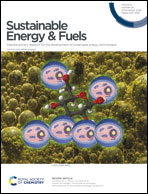Free-standing P-doped Fe2O3/ZnO nanotubes as a bifunctional electrocatalyst for electrochemical water splitting†
Abstract
Water electrolysis presents a sustainable pathway for producing green hydrogen; however, the commercialization of this process is hindered by the large overpotential associated with its anodic and cathodic half-reactions. Herein, we have developed a bifunctional electrocatalyst that can accelerate both half-reactions of water splitting by coating ZnO hollow tubes with P-doped Fe2O3 (FO-P2). The hollow tubular structure of the obtained catalyst averted the mass transfer limitation. Moreover, the study of the catalyst–electrolyte interface by the Mott–Schottky analysis revealed that doping Fe2O3 with P can enhance the charge transfer process by increasing the donor density and reducing the Debye radius. Owing to the synergetic interplay among these phenomena, FO-P2 displayed exceptional catalytic activity for the HER and OER, delivering a current density of 10 mA cm−2 at a low overpotential of 139 and 250 mV, respectively. With excellent stability for 144 hours, a symmetrical 2-electrode electrolyzer compiled using FO-P2 as the cathode and anode produced a benchmark current density of 10 mA cm−2 at 1.62 V.



 Please wait while we load your content...
Please wait while we load your content...